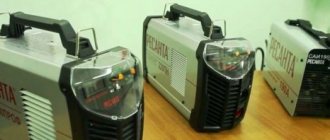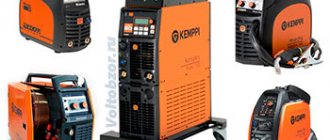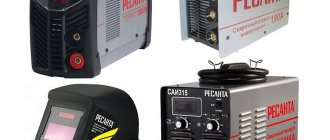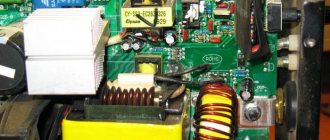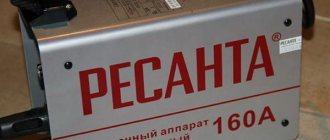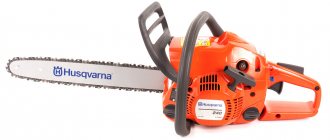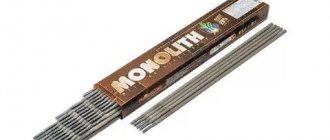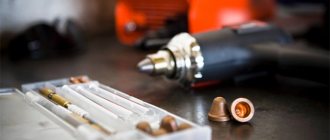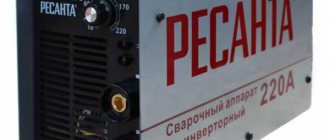Welding inverters through the eyes of a service engineer.
Welding inverters through the eyes of a service engineer.
Review of the Resanta SAI 160-250 PN series.
One of the most popular questions from buyers is: “what is the difference between devices from the same manufacturer, but with different maximum current?” There are many myths surrounding this issue, from “all devices are the same, the current strength is pure marketing,” to “completely different hardware under the same brand.”
We will try to study this issue in detail, through the eyes of a service specialist (http://svar.im), using a variety of different series of equipment.
You can find a more detailed analysis in the video review on our YouTube channel.
Today, we are analyzing welding inverters of the Resanta SAI PN series. Models before us
1) SAI 160 PN, 2) SAI 190 PN, 3) SAI 220 PN, 4) SAI 250 PN
Shall we start the autopsy?
We immediately see that all samples are assembled on the same type of factory-made monoboards. The version about “different models under one roof” and “handicraft assembly” can be safely discarded. Let's take a closer look at the differences, shall we?
Models 160, 190 and 220 PN have the same assembly and at first glance there are no differences, but when opening the SAI 250 PN, the differences in the circuitry of the switching power supply, input power supply and control board immediately catch the eye.
One of the easiest ways to roughly estimate the power of an inverter is to analyze the capacitors installed in it. As the characteristics increase, the total capacitance of the electrolytic input capacitors should also increase.
In the SAI 250 pn power supply, the number of electrolytic capacitors is 4 pieces, 560 microFarads each, in models 190/220 there are three electrolytic capacitors of 560 uF each, and in Resanta sai 160 pn 3 * 470 uF. Quite logical, a good “margin of safety”.
Now let's look at the power part. Models 190/220/250 have four IGBT transistors 50 jr 22, and resant 160 have 2 transistors Gw 60 v 60 df. On the 190/220/250A samples there is one transistor per arm, with a rating of 50A/600V, and on the 160th model there are only two transistors, but somewhat more powerful (rated 60A/600V).
No other significant differences between installations were identified.
So what do we end up with?
Models 190/220 are indeed very similar in hardware (or the differences are so insignificant that they could not be noticed). The difference is due to the maximum current limitation set at the factory using trimmed resistors, which will provide the inverter with a good gain in resource. A logical assumption arises that to “upgrade” the 190th model, it is enough to turn the regulator (at the cost of the model’s resource).
However, we will still check this at the stand.
Resanta Sai 160 is predictably inferior in terms of the rated power of the parts and, accordingly, at least in terms of service life. To catch up with its older brothers, it will have to undergo a serious modernization, which will cost (including work) comparable to the price difference with the 190th model, so the price difference between the models is completely justified.
The 250th model has serious design differences, which also fully justify its difference in price.
If we talk about the maintainability of these devices, then the clear winner is visible at first glance. Models 160/190 and 220A use traditional solutions for welding inverters based on SMD elements. SAI 250 PN is equipped with simple output radio elements, which are noticeably superior in maintainability to classical solutions, not inferior to them in technical parameters (although they are more expensive).
In general, the 250 model is deservedly and logically a favorite in all respects, from maintainability to potential service life. Unfortunately, so does the price. There are no miracles.
And now, let's move on to the actual tests of welding inverters for maximum current (the test was carried out on a ballast rheostat RB 301 U24, the current was measured using magnetic clamps).
A welding machine is a device that is indispensable for certain jobs in the construction and industrial sectors, agriculture and everyday life. A high-quality welding machine is a doubly useful and good assistant that can satisfy various production and other problems that require joining metals. The high-quality, reliable and modern machine Resanta SAI 190 is a bright representative of high-tech special equipment.
Review of inverter equipment Resanta SAI 190
The inverter device for welding Resanta SAI 190 is a reliable source of direct current with the ability to operate under significant voltage drops in the electrical network. If we compare the Resanta inverter with a conventional transformer , then Resanta has many advantages, including simplicity of spatial arrangement, small dimensions, and light weight.
Positive consumer reviews indicate the advisability of financial investment in the welding inverter of the product in question, and you need to figure out why?
- Mains frequency – 50 Hz;
- Mains voltage – 220 V;
- The maximum level of current consumption is 25A;
- Idle voltage – 80 V;
- Adjustable current level – 10-190A;
- Electric arc voltage 190-27 V;
- Load duration at 190A – 70%;
- Cooling system – forced, air;
- The maximum cross-sectional size of the cathode is 5 mm;
- Protection level – IP 21;
- Device power – 5 kVA;
- The weight of the device is 4.7 kg.
The best professional welding machines "Resanta"
Models in this category can be powered from an electrical network of 220 or 380 V and at the same time have a welding current of 200-300 A. They are used in car services, on construction sites or in the housing and communal services sector.
Professional welding machines from Resanta have a high operating time and also work with metals with a thickness of more than 15 mm for a long time, which affects their cost and dimensions.
Resanta SAI-250AD AC/DC
The features of the model include its versatility and ease of control. The device can be used for welding with both coated and non-consumable electrodes.
Despite its heavy weight, it is easy to transport, since it has a special handle on the body.
Welding current is adjustable in the range of 15-250 amperes. The maximum core diameter of 5 mm allows you to successfully process metal up to 20 mm thick.
The mode for setting the current decay time and the hot start function increase the comfort when using the device for both experienced welders and beginners.
Advantages:
- LED display;
- wide operating current range;
- support for argon arc welding;
- Ease of use.
Flaws:
- high price.
Resanta SAI-250AD AC/DC is universal and is capable of successfully processing metals using direct or alternating current.
The high performance and multitasking of the device allow it to be used in professional welding activities, large-scale production, and on construction sites.
Resanta SAI-250
The device is equipped with special terminals for quick and reliable fixation of cables. Light weight and wide shoulder strap allow the welder to actively move during welding work.
The minimum operating voltage is 140 V, the electrode diameter does not exceed 6 mm. Thanks to the simple adjustment of welding modes, the device is convenient to use when processing parts of various sizes and thicknesses.
Advantages:
- air cooling;
- convenient setup;
- compactness;
- high performance;
- thermal protection.
Flaws:
- difficulty of maintenance.
Resanta SAI-250 is used for welding on a construction site or in production. An excellent solution when laying pipelines or car repairs.
Frequently asked questions and feedback
The Resanta SAI 190 device can perfectly cope with everyday problems, but the power reserve of the device makes it possible to implement other tasks related to construction and production, where the requirements for the performance of this device are much higher.
The big advantage, as proven by consumer reviews, is the relatively inexpensive price, which allows you to buy a reliable and high-quality welding unit at an affordable price.
The cross-sectional limits of the electrodes enable Resant to work with metals of different thicknesses. Reading the consumer reviews, another advantage becomes clear that distinguishes this welding unit from older transformer-type machines - light weight, reaching about 5 kg . Thus, the device can be successfully used in different spatial positions, while being quickly and conveniently transported.
If at the dacha or in a country house there are problems with the stability of the network voltage, that is, sags occur, the inverter machine of this model is a faithful and reliable companion for the welder, since it can work with a voltage drop of up to 185 V (according to reviews, the PN model range can operate at 140 V). At the same time, this welding machine makes it possible to easily start an electric arc.
Reviews from professional users indicate the ability of the Resanta device to operate in conditions of very low temperatures, and this possibility is achieved through wires made with an insulating layer. At the same time, the wires are frost-resistant . The unit is equipped with high-tech inverter capabilities for RDS devices: hot start, cathode anti-stick, arc forcing function.
Questions and answers
Which device is better and more profitable for a dacha, area, rural area remote from the central electricity main?
For operation in areas where there are problems with power supply parameters , it is better to choose the SAI 190 model PN device; it has the ability to operate at significantly low voltage.
Is it possible to operate Resanta 190 equipment for fastening metal products up to 8 mm thick at low voltage?
The SAI 190 model inverter maintains stable performance at 190–250 V mains voltage.
What is the difference between the Resanta SAI 190 and 190 PN models?
The difference between the devices of this modification is that the second version of the device is designed for operation at a significantly reduced mains voltage, the lower limit is not less than 140 V.
Is there a polarity relay included, and is it possible to process stainless steel products?
To change the polarity of the current in the Resanta inverter, you need to swap the ground terminal and the electrode holder.
Is it possible to operate the Resanta model for argon arc welding of steel by connecting the appropriate torch?
This welding unit does not allow the worker to weld metals using TIG technology.
Does the device have standard inverter functionality?
The Resanta welding unit has a full range of options and functions that make work easier, including anti-stick, electric arc forcing, and hot start.
The difference between SAI 190 and the PROF and PN models is the inability to adjust the ArcForce function , and this must be remembered when purchasing a device. For better information, we suggest that you familiarize yourself with the review of PROF and PN devices.
Review of the PROF series
If you are an experienced welder who makes metal connections every day, then Resanta SAI PROF is what you need. But this does not mean at all that the PROF model is used only by professional workers, since this unit will also be useful for a beginner. In fact, the technical data of the PROF series enable the device to operate almost universally.
With an electric arc voltage of 26.4 V, the highest operating parameter is 190 A. PROF series equipment provides the ability to adjust the current indicator thanks to a digital screen protected with special glass.
The weight of the PROF series device is approximately 5 kg, and its dimensions allow the PROF equipment to work in different spatial positions. The case is made of impact-resistant material, and for effective cooling of the “insides” of the inverter, the developers have provided specialized holes.
Using a power factor corrector, you can increase the efficiency of the range at the input voltage of the equipment. In this case, minimal interference is generated in the electrical network , and its subsidence is prevented. The PROF series has small dimensions and weight, which ensures convenient transportation.
Which is the best welding machine to choose?
The choice of a suitable device depends on the purpose of use, parameters and technical nuances. If the important point is the weight, as well as the dimensions of the device, you should choose a compact model (SAI K). The weight and size of such devices are significantly smaller than other samples. For domestic use (garage, cottage), an inverter-type device (AI) is suitable.
When the network voltage is low, which occurs in rural areas, it is better to choose a device under the abbreviation “SAI PN”. Such equipment is capable of fully operating in the range from 140 to 160 volts. The remaining categories of equipment belong to the semi-professional and professional types. Such devices have increased power and additional options.
Principle and features of work
The device is successfully used for electric arc welding. Welding occurs with direct current using stick electrodes in manual mode. Low and medium intensity electrodes are compatible for this model.
The device, receiving alternating voltage at the input from the network, converts it into direct voltage. At the next stage, it converts the resulting DC voltage into a high-frequency voltage at the output.
Design features allow you to regulate the welding current during operation of the device. For this, the principle of pulse width modulation is used.
For those who are not yet familiar with devices like the Resanta SAI 190, the instructions for use will be a useful aid, which contains useful information about the features of its operation.
Design
Each SAI 190 model is equipped with a comfortable handle and a shoulder strap, which, combined with the model’s low weight (up to 5 kg) and compact dimensions, allows it to be carried comfortably.
Also, all of them have a safety class of IP 21, which ensures relatively safe user operation and low resistance to negative environmental conditions, such as gas pollution, dust and high humidity. However, the device has overheating protection with automatic power off.
Air-type cooling is modernized and is performed using twin fans, which allows the device to be operated at temperatures up to +40 degrees.
Features of operation of Resanta inverters
Before connecting the inverter to the electrical network, it is necessary to connect the power cable and ground cable to its connectors, and also check that its switch is in the off state. Before pressing the power button, it is necessary to set the minimum value of the welding current on the equipment.
The power switch for Resanta inverters is located on the rear panel
The electrical cable that connects the inverter to the power supply must be completely unwinded from the reel so that it does not create an inductor that could negatively affect the welding process. In addition, in order for the Resanta brand inverter to serve you for a long time and allow you to effectively perform welding operations, you must adhere to a number of recommendations.
- It is not recommended to work in the immediate vicinity of the inverter with an angle grinder or other tools, which are a source of metal dust that can damage welding equipment.
- There should be enough free space around the inverter, and its body should not be covered with cloth or other objects. This rule must be followed in order to ensure effective ventilation of the equipment.
- Inverters react very critically to high humidity, so they can be used and stored in dry rooms. It is also necessary to protect them from direct exposure to precipitation.
- If you brought the device into a warm room from the cold, you can start using it only after the condensation on the internal elements has completely dried (about 2 hours).
- The inside of the inverter should be regularly cleaned of accumulated dust, this will extend its life and minimize the risk of sudden failure.
History of brand development
Resanta welding machines are the only representatives of arc welding equipment in their price class. Indeed, compared to analogues, all models compare favorably in cost. The domestic consumer gradually developed the mindset that low cost is a direct indicator of low functionality or quality.
However, the Resanta model range allows a variable approach to the issue of choosing a device, both for a specific area of application and for a wide profile. In simple words, offers from the manufacturer should be of interest to everyone involved in welding work.
The company's experience begins to accumulate in 1993, when for the first time the electrical equipment market was replenished with devices bearing the Resanta brand. Initially, all production facilities were localized in the city of Riga. The newly formed enterprise was engaged in the production of voltage stabilizers. After analysts recorded an increase in demand, the company decided to expand, not only in terms of product range, but also geographically.
Resanta entered the Russian market in 2003. Almost immediately the company established itself as a responsible and customer-oriented supplier. The quality of Resanta products meets all modern standards. Production technologies do not stand still. Developers are constantly introducing advanced technologies to make the equipment competitive.
Multi-level quality control accompanies the entire production cycle. Attracting new customers is facilitated by well-functioning work with potential and actual customers. First of all, consumers note the high level of support service. In addition, a network of representative offices has been opened in Russia to provide service and repair of welding machines.
The inverter principle of voltage conversion is that the entire process consists of two time periods. During the first period, alternating current becomes constant through transformations, and in the second period, alternating current is again obtained, but with an increased frequency. For welding in MMA mode, coated electrodes are needed. Absolutely all models are considered compact, which allows them to be transported or used for high-altitude work.
